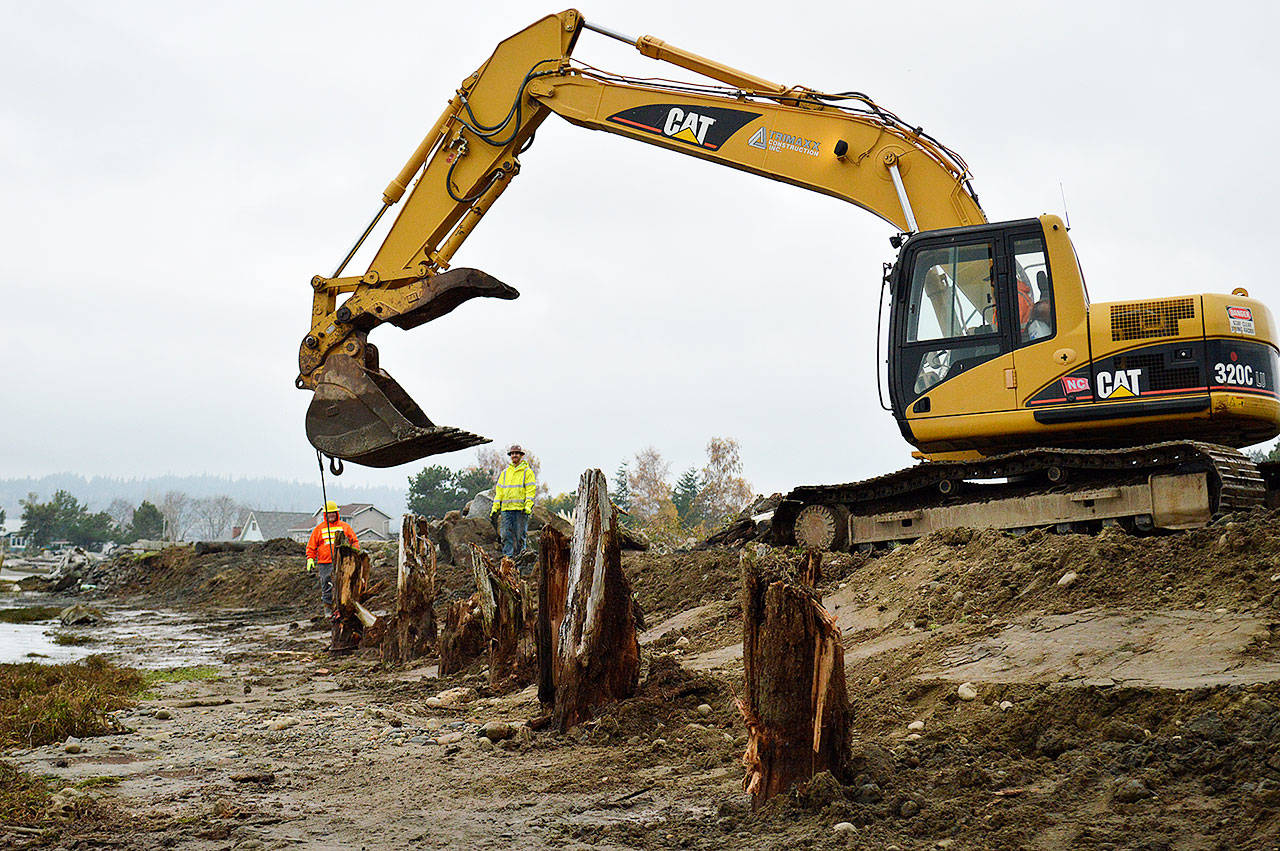When it comes to shoreline protection, it’s often better to take a “softer” approach.
Unfortunately, this wasn’t known for decades, and many areas resorted to hard armor to protect beachfront properties.
The Island County Marines Resources Committee (MRC) partnered with the Northwest Straits Foundation to restore Whidbey’s shores to a more natural state, working on projects across the island.
“Hard armoring may not be necessary in certain areas,” said Anna Toledo, marine resources committee coordinator.
In fact, it tends to do more harm than good, she said.
The recent removal of over a thousand feet of retaining wall, concrete and derelict tires at Maylor Point is already having a positive impact, according to Michael Bianchi, the natural resources manager for Naval Air Station Whidbey Island.
The Army Corps of Engineers used the cliff side of the Sea Plane Base to try a number of low-cost options for bluff protection during the late 70s, Bianchi said. Over the years, the concrete, tires and fencing had fallen into disrepair and it was later found to be ineffective anyway.
“It’s more important what you do at the top of the bluff,” he said, pointing to the edge of the cliff.
Where snowberries were planted, the edge held a tight line. In areas where the vegetation had been cleared, it sagged from erosion.
The MRC and Northwest Straits identified the area as a good project location for one of their armor removal projects. A coastal geological survey found that sediment from the area replenishes beaches in Crescent and Oak harbors, but the armoring hindered this natural process.
Grants from programs within the EPA, U.S. Fish and Wildlife and the Puget Sound Acquisition and Restoration Program funded the work to pull approximately 2,200 tons of armor material in October.
“The removal has really allowed the beach to return to its natural slope and sediment,” Toledo said.
Bianchi said he’s already witnessed new spawning sites for forage fish popping up, which is a big deal for salmon recovery efforts.
Whidbey’s waters are an important area for juvenile salmon to spend time and grow, said Lori Clark, the Island County Department of Natural Resources manager. These young salmon primarily eat forage fish, such as krill and smelt.
“It became immediately apparent that the beach was changing and that was pretty exciting,” Bianchi said of the shore after the removal.
On the South End, the groups are also working to restore habitat in the Sunlight Shores community in Clinton. A resident attended a county meeting about shoreline management and reached out to Toledo about the area’s failing bulkhead.
The committee with complementary funding from Northwest Straits conducted a site visit and again found the armoring was doing more harm than good. The logs in the ground that created the wall against the shore were treated with creosote, Toledo said, which is a toxin.
Lisa Kaufman from the Northwest Straits Foundation heads the team that does site visits for residents in the region that want to determine if their armor can be removed or replaced with an alternative.
She pointed out bulkheads don’t help with flooding and actually prevent the water from going back to sea in some cases, trapping it in lawns or basements.
With funding from the foundation, excavators started last week the process of removing 350 feet of bulkhead that is estimated to have been in place since the 60s. After it’s removed, Kaufman said they’ll begin the process of planting native species to prevent erosion.
Once the shoreline returns to a more natural state, the ecosystem should see similar benefits to the Maylor Point project. Toledo said the improved connection between the uplands and water will mean more insects will go in the water, which can then be eaten by juvenile salmon.
The gentler gradient into the water will also improve access by the community members, Toledo said.
Vivian Stembridge, the community member who had approached Toledo about the project, said she is excited about the impending results.
“In the summer it will be nice to stick our toes in the water,” she said, “and, possibly, launch a kayak from the shore.”
• Individuals or groups interested in shoreline armor removal or replacement can contact Lisa Kaufman at kaufman@nwstraitsfoundation.org



